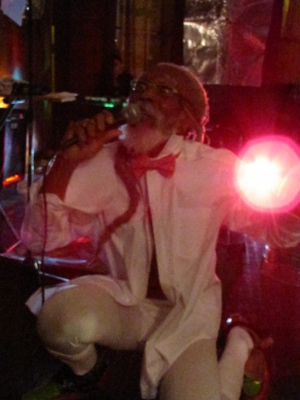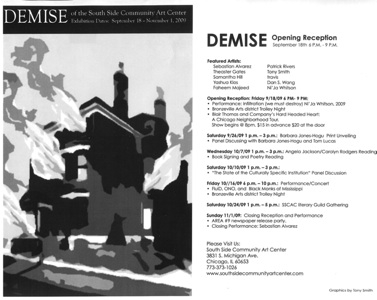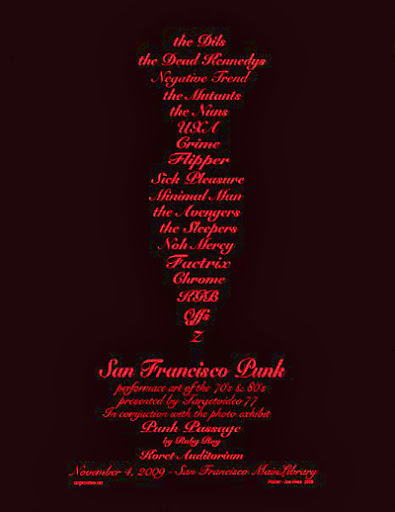
Photo by Joe Carducci
From the desk of Joe Carducci...
The Algorithm of Radio’s Death Spiral
“The Song Decoders” in the New York Times Magazine is about the internet radio-service Pandora’s Music Genome Project, an attempt to log and cross-ref “hundreds of data points” that are alleged to determine what it is a listener hears in a song and will presumably search out in other songs.
Well, okay, here’s what Pandora tells you about three songs that Chris checked out for me when I told him I was working on this:
Black Sabbath “Hole in the Sky”
Features of this song:
- hard rock roots
- mild rhythmic syncopation
- repetitive melodic phrasing
- a twelve-eight time signature
- mixed minor & major key tonality
- groove based composition
- a vocal-centric aesthetic
- electric rhythm guitars
- a dynamic male vocalist
- triple note feel
- similar songs are: Smashing Pumpkins "Today", Motorhead "We Are the Road Crew", Ministry "Supernaut", Led Zeppelin "Houses of the Holy".
Amon Duul II “The Return of Ruebezahl”
Features of this song:
- electric rock instrumentation
- extensive vamping
- minor key tonality
- electric rhythm guitars
- an instrumental arrangement
- similar songs: Kennelmus “Goodbye Pamela Ann”, Nektar “The Nine Lifeless Daughters of the Sun”, the Avengers VI “Heartbeat”, the David “Mister, You're a Better Man Than I”, Wigwam “Pig Storm”.
Black Flag "In My Head”
Features of this song:
- punk roots
- electric rock instrumentation
- a twelve-eight time signature
- minor key tonality
- a vocal-centric aesthetic
- electric guitar riffs
- a dynamic male vocalist
- triple note feel
- similar songs: Jesus Lizard "Uncommonly Good", the Birthday Party “Say a Spell”, Shellac “Canada”, Heatmiser “Dead Air”, the Butthole Surfers “Sea Ferring”.
Pandora notes after each song breakdown, “[t]hese are just a few of the hundreds of attributes cataloged for this song by the Music Genome Project.” I don’t doubt that but as Ray Farrell tells me the tunes suggested by non-genome software at All Music Guide or iTunes are not so different. (Ray went from Rather Ripped Records to KPFA to Down Home to SST to Geffen to eMusic to RoyaltyShare.com so he about knows it all.) Just posted at Arthur is an interview with Josh Homme and John Paul Jones where Jay suggests that no matter how fringe the artists one enters into Pandora, the algorithm gradually moves you “to the center. It doesn't run around the edge,” which Homme then christens a “Vanilla-ator.”
Satellite radio attempted to please the music consumer by programming many channels by micro-genre -- a thousand narrowcasts. But what they play is ordered from over the heads of the on-air talent, even when that be music people who know far better what to play. Pandora’s answer is a more mechanistic attempt to fix what was broken back when radio got rid of all its music people. But Pandora does not want music people back either, because they might commence to listen, respond, and program with little regard for business considerations. (Managers and labels often threaten to withhold their big stars unless their newbie-foists are programmed.) Things could open up in uncontrollable ways, recombining as they might.
Music people as such were driven out of radio by 1973 or so, and since then earlier versions of these Numbers people created this death spiral which promises radio station owners better targeting of existing listenership and then proceeds to deliver smaller and smaller audiences as people tune out radio itself.
Station-owners’ answer has been to switch formats, but these too have the same problem: Country or R&B or Rock or Pop formats can only profit marginally from the ebb and flow of each other’s deterioration. Why? Because a programmer must build an audience through contrast and drama, and he needs to know music much better than the listeners, the sponsors, the sales people ever will. He has to be assembling and educating an audience for music that does not at first exist.
If the DJ himself has a clue and a personality you get something like you once had after ASCAP (American Society of Composers, Authors, and Publishers) and the musicians union mercifully pulled all their professional pop music off the air in a bid to halt the playing of records over the air. They’d colluded to prevent this for a decade and clearly felt they could stone it for another. Radio then founded BMI (Broadcast Music, Inc.) to collect performance fees for the country and blues they’d been filling the air with for a year before a settlement was reached. To the astonishment of the musicians union head James C. Petrillo and ASCAP, BMI’s signings out of ghetto and holler stayed in the air, laying a path for Sun, Chess, and the rest.
In any case there was nothing but the Race and Hillbilly charts in Billboard for early rock and roll: Bill Haley on both, Elvis Presley on both… The Pop Chart wasn’t really conquered until Elvis’ end run around pop radio formats via a run of appearances on network television programs: “Stage Show” - CBS, “Milton Berle” - NBC, “Steve Allen” - NBC, “Ed Sullivan” - CBS. Thereafter Elvis, Chuck Berry, Gene Vincent on all three charts, and if there‘d been a Gospel chart….
But it was a golden age due more to the music than media. American balladry had blued up under the influence of black Americans, and then it rhythmed up after the Civil War as Rags, Stomps, and varied Dance crazes washed over the music culture via early twentieth century jazz which was then further disseminated through the new media of records, radio, and then film and television. Rock and roll had built up a head of steam.
But radio and records gradually were taken from the hands of music people and low-life hustlers, and delivered into the hands of suits and swells, lawyers and accountants. And as done elsewhere they standardized products and routinized their selling. Music folk had to leave the business-side. Soon enough they were getting thrown out of the music-side too.
Something I like to do is periodically keep my eye off the ball. Well maybe keep it in peripheral vision, but look around a bit -- see who is moving where while attention is elsewhere. It can be enjoyable after a rec-biz career like mine to relish each internal crash of its collapse, but what’s more important is that as the old major labels threw themselves against the web, they did manage to rescue copyright for the big music publishers (Warner-Chappell, EMI, SonyATV, Universal…) to now wire up that web. Publishers do their promotion behind the scenes for satellite radio, advertising, television and movie soundtracks, etc. The promotional working of songs isn’t as visible as billboards and record shop display ads anymore, although NBC’s signing Bon Jovi as “performer in residence” to be “seen and heard across the multiple brands and platforms of NBC Universal” was so ridiculous they figured they’d have to make it visible.
Ray thinks Pandora’s new social networking feature that shows the playlists of others who have requested the same song is going to open up the system to knowledge beyond what their software scientists can isolate and identify. It also allows one to listen to what they’ve downloaded so may prompt more lawsuits.
But all these mechanisms to replace the old radio model that worked, turn music-hunting into something analogous to code-writing when what a listener needs, especially a young one, is have their code written by the ambient programming of a musically rich culture that comes at him or her from all directions in all styles, live and recorded. There still are music people in this country, Ray and Jay for two, but media has damaged content. There’s no doubting that at this point. And as the music industry people go about their survival drills they don’t see another way even as they claim to be looking for nothing else.
***
The NYT had an interesting review of a book called “The Curse of the Mogul”, written by three authors “bringing academic, financial and managerial credentials to their scorching critique of the media industry.” Apparently their argument is that it wasn’t even good business to build these behemoths, nevermind what they did to journalsim, the arts, etc. Especially as the media business has kept the first-person carny-hustler model of a Col. Tom Parker, their corporations dodder around in the dark like late Elvis looking for the fridge. Perhaps the internet’s creative destruction of Viacom, Disney, Comcast, TimeWarner, etc., is further disguising culpability.
The authors, according to reviewer Harry Hurt III, are suggesting these companies would have been better run on “traditional economic theory” with closer relationships to local rather than world markets. (This jibes with my sense that even with regard to Pop music, world Pop musics are far inferior and have harmed our style which comes of a far deeper syncretic tradition.) And here is Ted Turner right on time to confirm this, telling Bloomberg news in the same sit-down that he, 1) Feels like a dummy, and 2) Would like to get control of TimeWarner so he could run CNN again.
***
Proof comes periodically that Chicago needs the Sun-Times, yea verily, but these hipsters Daley has made the city safe for don’t even read the Reader anymore. Sunday Sun-Times’ look at ex-Gov. Blagojevich’s database includes a sidebar on the President’s efforts on the behalf of his own list of ne’er-do-well shirt-tail brothers-and-sisters in Chicago politics. The Tribune has always been a regional paper for the mid-west and was further pulled from the city by its suburban strength -- though that‘s taken blows from the Daily Herald. The Trib’s one legit street feature is John Kass’s column. It’s now a tabloid on weekdays to compete with the Sun-Times for rail and bus commuters, but still a not-so-broadsheet on Sat & Sunday. The two papers don’t have much in common except for regular twin bouts of Wilco-mania, interrupted whenever R. Kelly drops his drawers. This is somewhat an improvement over the old days when the papers’ music writers would come together over the legitimate promotional needs of Styx and Richard Marx.
***
“Where the News Comes From” is an interesting experiment by New York magazine to track coverage of several news stories back through to the original reporting to find out where the real reporting was done -- currently a subject of much talk in journalism. Nice to know some editor and reporter team eventually decided to look into it.
***
This Chicago Reader review of Barbara Ehrenreich's new book gets at a contemporary syndrome.
***
The French language ain’t makin’ it. Xavier North, head of the General Delegation for the French Language and the Languages of France, claims, “Our citizens have a right to communicate without speaking English.” Okay, but don’t let me catch you speaking Italian neither.
***
The Comedy of the Commons.
One thing I remember about living up in northern Wisconsin is that once you log your property you can't sell it. Firewood, like beer and ammo, is used as scrip up there, but one would rather log the commons for spending money, and keep your property wooded for sale at top dollar. The trick is how to work your political representatives so as to get a no-bid contract to level some corner of public forest that you don't personally need for hunting. All in all, I chose Wyoming over Wisconsin.
***
ONO, Travis - Friday, "The Demise of the Southside Community Arts Center"

Photo by Tamara L. Smith
 I first heard about ONO from Al Jourgensen when he hung around the bay area after his band Special Affect broke up in San Francisco. Systematic was distributing the SA album. Al went back to Chicago and produced three recordings for ONO which became part of their first album, "Machines That Kill People" which Jon Boshard and I released on Thermidor in 1982; they followed up with a second in 1986, "Ennui". As far as I know ONO have the noise-gospel musical genre entirely to themselves. I first saw ONO play at Lincoln Hall on the Northwestern University Law School campus in downtown Chicago. They performed what they called ZADA for a scattering of weirdos in a large, classical looking lecture hall on February 12, 1982. Looking for them beforehand, as I'd never actually met them, I came upon Travis running down the hallway in a bridal gown and veil. I decided not to interrupt him on what for all I knew was the happiest day of his life. In those years of Ma Bell's long distance rates and federally regulated air travel, most independent record label business was conducted by mail, and oft-times one suspected one ought feel grateful for that.
I first heard about ONO from Al Jourgensen when he hung around the bay area after his band Special Affect broke up in San Francisco. Systematic was distributing the SA album. Al went back to Chicago and produced three recordings for ONO which became part of their first album, "Machines That Kill People" which Jon Boshard and I released on Thermidor in 1982; they followed up with a second in 1986, "Ennui". As far as I know ONO have the noise-gospel musical genre entirely to themselves. I first saw ONO play at Lincoln Hall on the Northwestern University Law School campus in downtown Chicago. They performed what they called ZADA for a scattering of weirdos in a large, classical looking lecture hall on February 12, 1982. Looking for them beforehand, as I'd never actually met them, I came upon Travis running down the hallway in a bridal gown and veil. I decided not to interrupt him on what for all I knew was the happiest day of his life. In those years of Ma Bell's long distance rates and federally regulated air travel, most independent record label business was conducted by mail, and oft-times one suspected one ought feel grateful for that.Though I moved back to Chicago for ten years, Travis's Bio page shows that ONO wasn't very active in that period. Now they are very active. I met them at my Quimby's booksigning, and now that I'm in the area I went down to see them Friday at a special performance as part of "The Demise of the South Side Community Arts Center". It wasn't a gig per se, but Travis opened things with FluiD, a one-man psychedelicized electronic band who then played his own short instrumental set. Then Ono performed "Ode to Billy Joe" as a funeral dirge psychodrama. Great sounds. The Bronzeville Art Trolley stopped by during ONO's set and the place filled up nicely. After three decades of south-side "Onomatopoeia Before Music" perhaps Travis and P. Michael have become a micro-institution. Still, Travis assured me the Art Center was uneasy about this whole "Demise" program, which was occasioned to take advantage of the coming renovation of the Center's rooms. The Center is a south-side institution and it was dedicated by Eleanor Roosevelt in 1941. Mighty nice of them to let the noise and graffiti up off the street and into the place. The walls are coming down anyway (they'll be auctioned). I didn't stay for the Black Monks of Mississippi performance but I met one of the players and he knew my name from the rock book.
The official ONO timeline
ONO photos and videos
From the desk of Steve Beeho:

Stooges live recordings from 1971.
From Andy Schwartz:


Drawing by James Fotopoulos
Monday - Naperville, Illinois

Photo by Joe Carducci

To receive a weekly update notice for the NV, send an email to newvulgate[at]sbcglobal.net with SUBSCRIBE in the subject line. To stop receiving notices, do the same with the word UNSUBSCRIBE.
• The New Vulgate
• Joe Carducci, Chris Collins, James Fotopoulos, Mike Vann Gray, David Lightbourne
• Copyright retained by the writer, artist, or photographer
I interviewed Pandora founder Tim Westergren a few years ago for the weekly "endless lists of arts & entertainment options" magazine that gave me the heave-ho last year. (I'm not bitter, just bloodied. At least based on Carducci's piece above, I may now convince myself I'm a "music person"...and/or, just a comical martyr.) Anyway — Westergren was unflappably pleasant and I seem to recall that he linked his belief that music could be celebrated and shared and loved as a sum of "genomes," admitting that there was an entire dimension (or three) to music appreciation and understanding omitted in the process, to his experience playing music in jam bands in/after college, and the way that brought people together. If Phish fans also like...(help me here)...moe., then wouldn't it follow that Sabbath fans will like Smashing Pumpkins? Would be cool to see their social-networking transcend its reductive roots in ways they wouldn't have predicted. Thanks also for pointing out Arthur's articulation of Pandora's sweeping things toward the center — I had the notion of a whirlpool constantly rotating toward a center point, but the idea of a street sweeper continually brushing things into the narrow space between the two yellow lines is more apt.
ReplyDeleteThe New Vulgate is my Oprah Winfrey show. I am now reading Manny Farber, and I just subscribed to the Financial Times.
ReplyDeleteGreat photography and art.
Regarding Pandora, et al:
ReplyDeleteWhat does "excessive vamping" mean, really? Apparently, it inhabits all of my favorite music.
I just got hip to the Pandora, dug it for a while, found that some "stations" were more useful than others. I plug in Leatherface and I get an endless loop of that band, Fugazi, Lawrence Arms and Jawbreaker. I plug in, say, Mission Of Burma and I get nothing but Fugazi and Dinosaur Jr. I start to get the idea that I could plug in Joe Turner and a Fugazi song would pop up. But for some artists, it works--Hawkwind and Can brought up lots of stuff I'd heard about but never actually heard. I'm sure, Joe, that those stations would bore you to death, but I'm kind of a neophyte on those grounds. I think if you're really proactive about finding new music (and critical), Pandora can be very useful. Even moreso, and with less of a "scientific" bent, with last.fm (and perhaps others), which has more songs and artists than Pandora, but no "genome," (which, as far as I can tell, is far from a panacea toward reading the mind of the listener). Last.fm does things that Pandora does not, and again, the way it works seems to differ station to station. I've got Buffalo Tom on right now, and it's an endless loop of Beetie Serveert and Lemonheads songs--not too interesting. But for more obscure artists, last.fm seems to rely on regional identification. Plug in Form Of Rocket, and you get stuff from across the Salt Lake City spectrum. In the case of that scene, the unfamiliar listener is rewarded with the fruits of a very vibrant and exciting pile of bands (with some crap thrown in, natch--none of these websites seem to have a quality vector built in). (P.S., a good chunk of that scene's history is available for free download at rest30.com, if anyone wants to take me up on the recommendation). Same with Motorpsycho--I got a dose of the Norwegian scene, much of which is difficult to come by in the states. The long and short of it is, these sites do for me what I've tried to do by surfing Myspace friends lists--mine the dregs. And trust me, doing it oneself through that process is not efficient. And sometimes, I hit on a station that is pure comfort food: plug Replacements into last.fm and you get a smorgasbord of quality grub ranging from Big Black and Wire to Lifter Puller and Wilco to Gun Club and Wipers to Exploding Hearts and the Obits--that's covering a broad geographic, temporal and stylistic range. I think criticism of the methods and results of these endeavors is useful, but at the end of the day, sites such as Pandora and last.fm do a lot more for the active listener than do FM radio on one end (by virtue of homegeneity) or Myspace or the blog scene on the other (by virtue of needle-in-a-haystack syndrome). Regarding the alleged "mainstreaming" of stations, I find that most work laterally, i.e., they tend to link to peers of the target group. I haven't seen much of a tendency to "mainstream" except in the case of bands that aren't licensed with either site (an unfortunately common occurrence that will likely only improve). I might change my mind in a few months as I get tired of this stuff, but for now, I give 'em the thumbs-up (especially last.fm).